#puzzle visual novel for the Nintendo ds…
Text

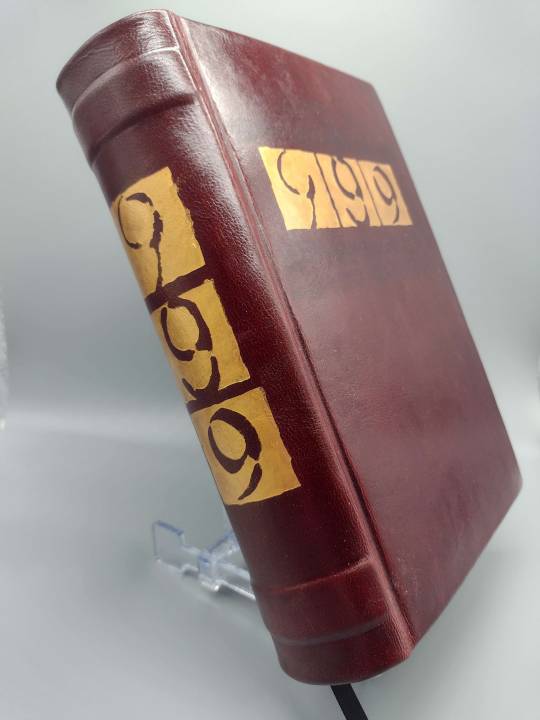






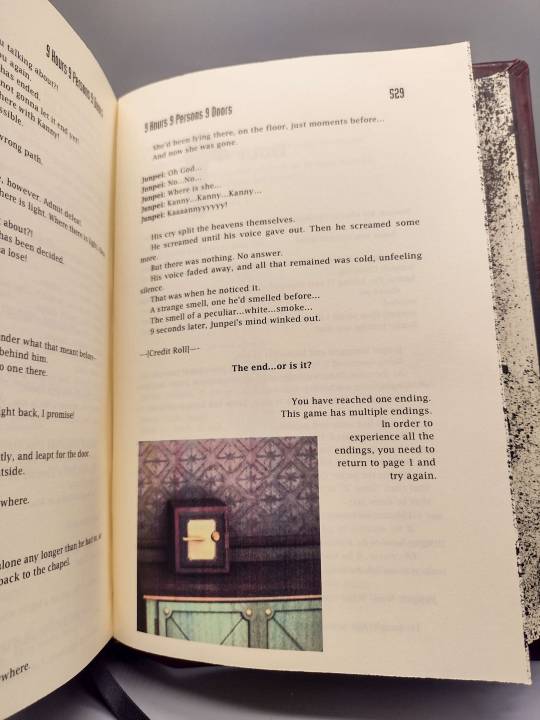
One of the largest projects I've been working on is this typeset and book version of 999: 9 Hours, 9 Persons, 9 Doors, one of my very favorite video games. (Which later became the first game in the Zero Escape franchise.)
The game is a visual novel and escape room game combo with multiple routes and endings leading to a true ending. So this version is structured like a Choose-your-own-Adventure book where you flip to different pages depending on your choices.
I also made it possible to skip all the less linear escape/puzzle sequences because they don't read very cohesively. But they do contain a lot of funny or revealing lines so I didn't want to eliminate them entirely.
I should also mention one of the reasons for doing this is that I wanted to preserve the original text of the game from the Nintendo DS version from 2010. When it was remastered/ported to PC and Switch a lot of the dialogue was rewritten very much for the worse. As well as making the novel sections optional, which destroys a lot of the point and atmosphere of the game.
The book is a full leather casebind, with stenciled titles. The leather was honestly a little too thick and required a lot of paring, which is terrifying because any slip could ruin it. And the final satin finish I put on made a lot of the leather flaws look worse and more obvious, which is annoying. It was my first time doing faux raised bands on the spine, and they came out nice.
My printer decided to fuck with me while printing this one and the color alignment is off. This is my second attempt at printing it and it's better than the first but still not great. But I wasn't gonna waste so much paper again.
And no, I'm not planning on doing the sequels. I can't imagine trying to deal with VLR's 28 endings when doing 6 was this challenging and annoying. And the sequels are perfectly represented by their existing playable versions, unlike 999.
1K notes
·
View notes
Text
when the function has 2000s era visual novel puzzle games released on the nintendo ds
871 notes
·
View notes
Text
everyone go play 999 for the nintendo ds. NOT THE PORT. the ds.
im serious about this.
9 hours 9 persons 9 doors for the nintendo ds is a masterpiece of a game, with wonderfully snappy dialogue and a quickly paced narrative that avoids many traps of visual novel writing (such as being overly obvious and repetitive) with a ludonarrative cohesion that makes SO many of its aspects initially perceived as flaws into an active strength of the experience. the endgame twist is very possibly the best in gaming history.
i think i've made it pretty clear that i really fucking love this game, and recommend it to everyone.
so
i used to say "the ds version is better, but it's fine if you play the port for its various quality of life features" but im no longer able to have that stance, now that i know the extent of how it kinda butchers its narrative. it's not super obvious, but that subtley honestly makes it worse to me.
it's the difference between a good game that had cool concepts but kinda shaky execution, and a masterpiece.
this boils down to the "novel mode" versus "adventure mode" format that they decided to build the port on.
if you choose to play in adventure mode, it removes almost all of the narration and rewrites that aforementioned incredible dialogue to awkwardly shove in some (not all) of that information, resulting in overly obvious and clunky writing that seriously drags some scenes out. the descriptive text in general is actually incredibly important in a way i can't describe, and though it will forcibly shift to novel mode to show it to you very occasionally, it's not Nearly enough and you will miss out on some of the most memorable striking moments because of it. i cannot overstate how much the impact of the ending is affected by this.
if you choose novel mode, you do get all the narration (very important). HOWEVER. the writing is still the adjusted one done to facilitate only playing adv mode, so now the dialogue is overly obvious and clunky and slow AND repetitive (all the things i said 999 very cleverly avoided 🤔?) and then, for some ungodly reason, it is actively difficult to play the game in novel mode. the game will Constantly shift you back to adv mode so you have to spend the entire game checking to make sure to switch back (something even i found difficult to do as someone who'd played the ds version).
so neither way to play the port is good. in addition to the aforementioned changing the final puzzle to be worse. and a LOT of ludonarrative things i cannot actually get into due to spoilers.
"how much of an impact could these small changes actually have?"
well this is anecdotal, but me (and many other people i know) who originally played 999 on the ds and thought it was a masterpiece, years later went on to play the port version and thought "huh. it was still good, but it's like the magic was gone. i guess it's just not as good as i remembered, one of those things that doesn't hold up to your memories of it."
and then we replayed the ds game. and found out that the game we remembered DOES still exist! it's just as fantastic, the magic IS THERE. the port just made the game worse!!
anyways, so what were those quality of life changes i mentioned earlier?
in the original ds version of 999, every time you reach an ending you have to start from the beginning of the game again, fast forwarding through the text and replaying the puzzles. (the port changed this to having a flowchart where you can just jump to decision points)
HOWEVER
as someone who Very recently replayed the ds version, i truly don't think this is as much of a pain as you might expect.
skipping text isn't a big deal. yeah it takes a bit, but it's easy to watch a youtube video or something while you're waiting the 5 minutes it takes. using an emulator, you can even speed up the text skipping to an even greater degree. if you can't physically hold down the button, you can probably find something to hold it down for you, and on an emulator you can rebind the key to be something easier to do that with (like the space bar)
redoing puzzles isn't a big deal either. not only do you still have to redo some puzzle rooms in the port version anyway, it can be pretty fun to figure out how to essentially speedrun rooms you've done before, and you don't redo them that many times (i would recommend a walkthrough anyway for deciding which endings to get, so making that redo time even shorter is a bonus).
if you really need the accessibility of voice acting, i would genuinely recommend watching an LP of the ds version instead. yes, i really do think some guy from 10 years ago reading out the text will give you a better experience than a genuinely good cast of voice actors reading the port's.
btw, if you're scared off at the prospect of reading a little more now without being able to choose adventure mode... if you've played danganronpa (and most of you did!) 999 is shorter, faster-paced, and has LESS READING.
okay im done.
i'd recommend THIS WALKTHROUGH, even if you don't want to use it for the puzzles, it'll give you good info for how to get each ending (especially recommended for true ending), and a general order to do them in. i'd recommend doing getting all the endings (except coffin, which is just the true end cut short) EDIT: thank you to tlblitz for recommending this walkthrough, which gives additional hints for the puzzles instead of just telling you solutions outright
if you've already played 999 (or are just curious about specifics), this video details all the changes mentioned here and more, and it gets all the way into spoiler territory (it can be nitpicky at points, particularly at the beginning, but maaaan did it open my eyes to everything i had subconsciously picked up on in playing the port)
EDIT
i forgot to mention. if you emulate the game, there's a visual glitch that messes up the sprites a little, but you can fix it really easily! in DeSmuME, go to Config>3D Settings and set the renderer to OpenGL
also, here's a mod that increases the text speed, if you find that bothers you.
and i figure i should put my reasons for not just tolerating, but loving the hassles that come from the ds version onto the base post (reposted from another reblog)
major major 999 spoilers below (and some vlr spoilers too)
-----------
to me, one of the coolest aspects of 999 (and zero escape in general) is how much the experience of playing it reflects the narrative
the final twist isn’t just that the text on the bottom screen has been akane, but that you’ve been playing as HER the entire game, not junpei (and with turning the ds upside down for the sudoku, you finally do so for the first time)
in the narrative, you spend basically the entire runtime getting to know her as June, but in the ludonarrative, (the actual Playing the game) you get to know her as Zero. and those annoying bits are a big part of that.
every time akane reaches her death in a timeline, she has to go back to the beginning and start over, because that’s how her powers work. she has to redo all the puzzles, has to wait through all the dialogue until she gets to a point where she can nudge junpei to another route. (in vlr, sigma+phi have a flowchart not just because it’s more convenient, but because that’s how Their powers work).
so subtly, without noticing, you start to reach her point of view. the first time you see the ninth man die it’s shocking and horrific, but even just on your second playthrough the horror doesn’t affect you much. for junpei and everyone else, these sequences are just as terrifying in every route but not for you, cause you’ve seen them before. you can’t be affected by them in the same way, what matters now is the futures you haven’t seen yet.
speedrunning puzzles by skipping the clues and zoning out while you wait for the dialogue to finish aren’t just game things, but diagetic events, of akane going through the motions of something she’s done over and over.
when i replayed the ds version recently (something i hadn’t done in a LONG time), i felt so close to akane in a way i never did in the port, because i’d been through the same experience as her. i understood how she could be such a kind and sensitive person who rationalizes away putting all these people she loves through all those the moment to moment horrors in pursuit of a timeline where she and everyone she care about lives, because i’d become detached to them through repetition too.
i completely understand why people wouldn’t enjoy that, but i’m a pretentious gamer who LOVES when mechanics are technically “worse” in a way that is characterful or thematic. so the frustrating bits of 999 add to that experience much more than they detract from it for me haha
#zero escape#my post#this is half advice half rant LMAO#i love this video game a normal amount#long post
71 notes
·
View notes
Text
2023 Game of the Year Countdown
Honorable Mentions (part2)
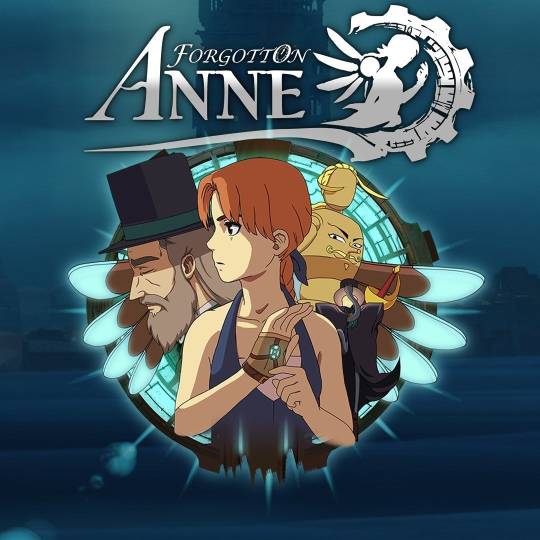
Forgotton Anne
Nintendo Switch, 2018
Nope, that is not a typo. They really did spell Forgotton with three o’s and not a single e.
This is less of a game and more of just a story you can experience. There are light platforming aspects and some puzzles to solve, but it is rare to find yourself under the gun or anything. I was more concerned about the moral questions that I was confronted with during the game, including from the very first decision I had to make.
The game looks very pretty as the characters were hand drawn in a Ghibli-esque style, which gives it a sort of calming charm while still bringing some difficult ideas into the spotlight. I can’t really talk too much without spoiling the story or the ideas the game wants to make the player ponder, so I’ll have to leave this review fairly short. The game itself is short and only has two endings, so just go buy it when it goes on sale or something! (I think it was $4) I’ll just end this short write-up with my favorite quote from the game, spoken to you by someone you’ve most likely wronged thanks to your own bias: “We all do better when we know better.”
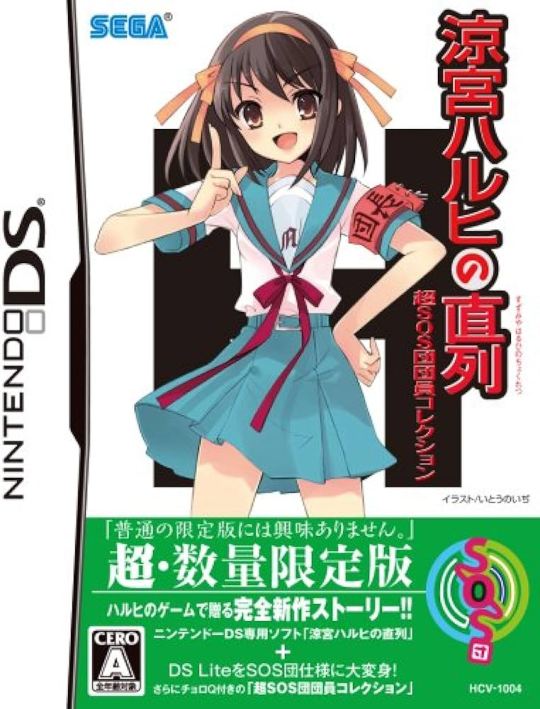
The Series of Haruhi Suzumiya
Nintendo DS, 2009
This is a visual novel with some interactive aspects that heavily use the touchpad. While the actual “game” parts are not particularly great, the experience is an absolute joy for Haruhi fans. Originally only released in Japan, fans have been slowly translating the game and releasing each chapter as they finish it, so it’s not yet complete. The fans are very dedicated and every line feels 100% true to each and every character, even side characters who are mostly inconsequential. If you don’t like Haruhi or don’t know what the series even is, skip this entirely. But if you are a fan, it’s a fun and accurate excursion with the SOS Brigade. As a Haruhi fan myself, a franchise that is mostly dead, it was really fun to find something a bit like a lost chapter in the Haruhi story.
#game of the year#goty#countdown#forgotton anne#the series of haruhi suzumiya#nintendo switch#nintendo ds#haruhi suzumiya
9 notes
·
View notes
Text
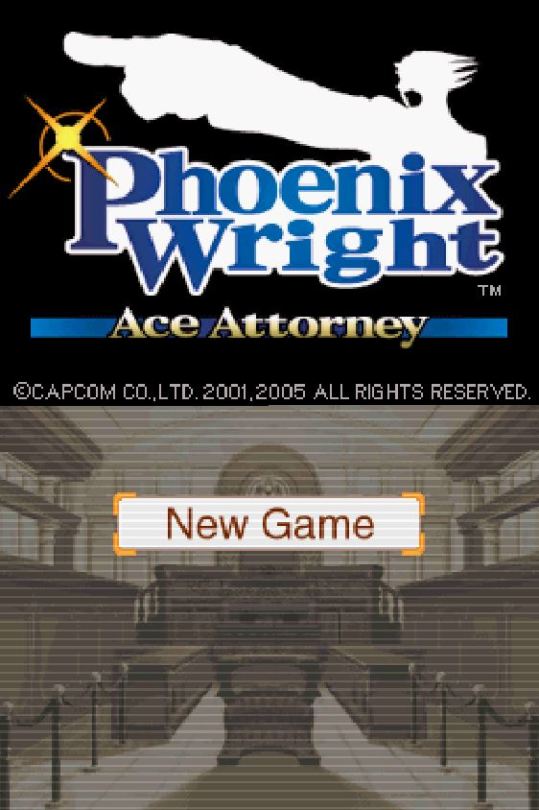

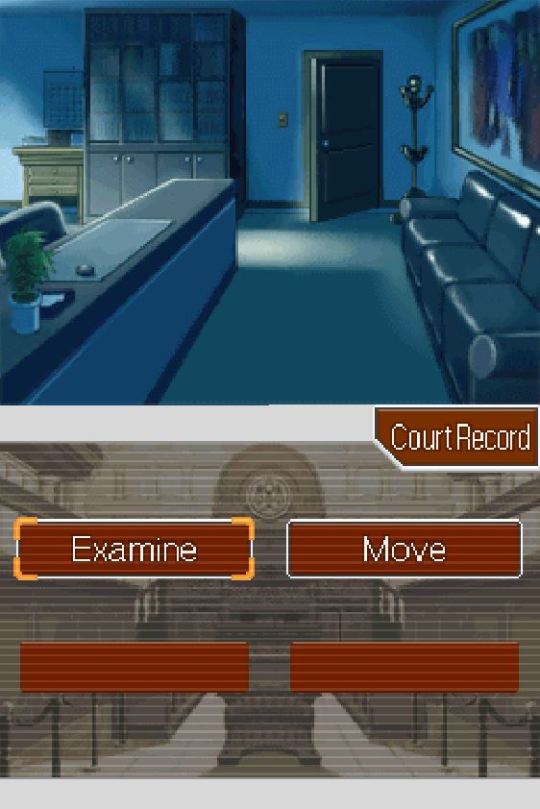
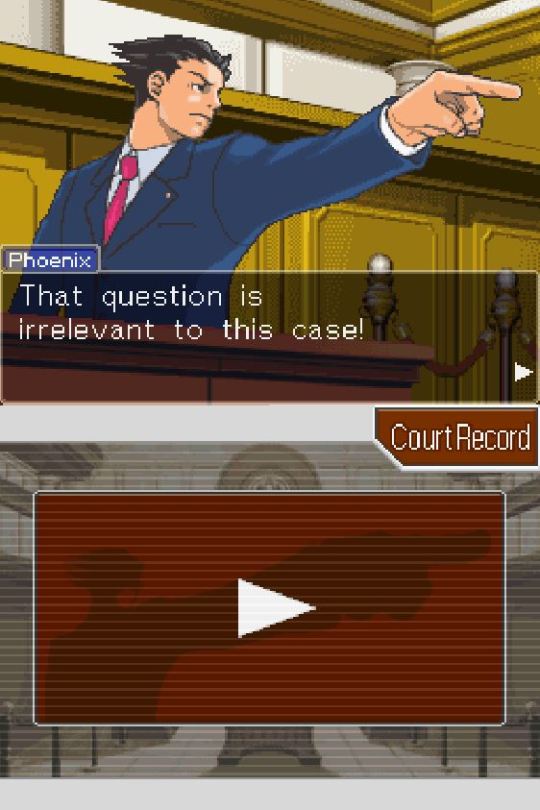

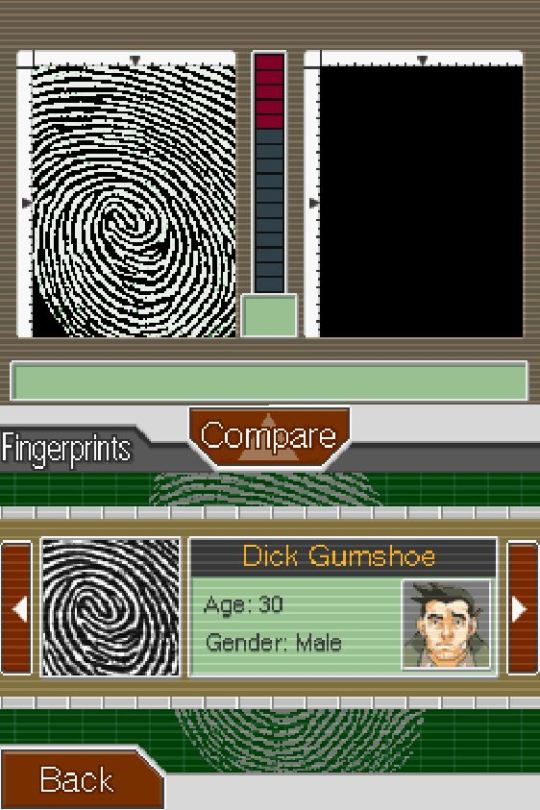
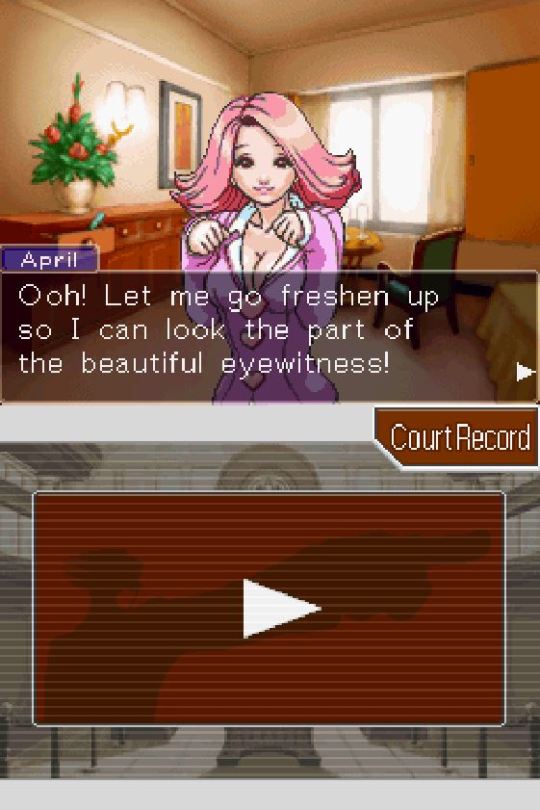
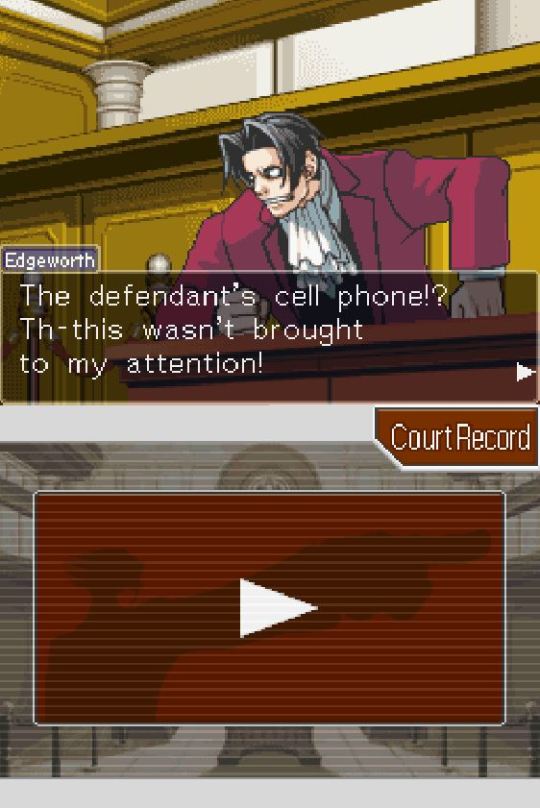
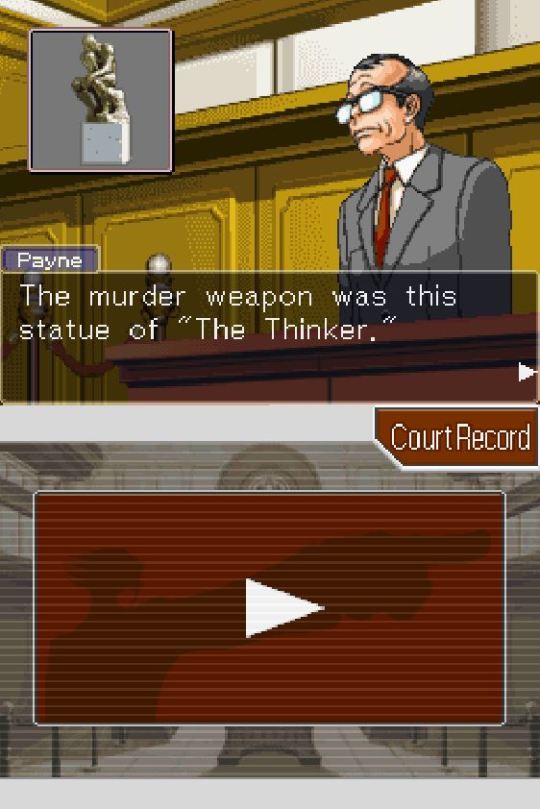
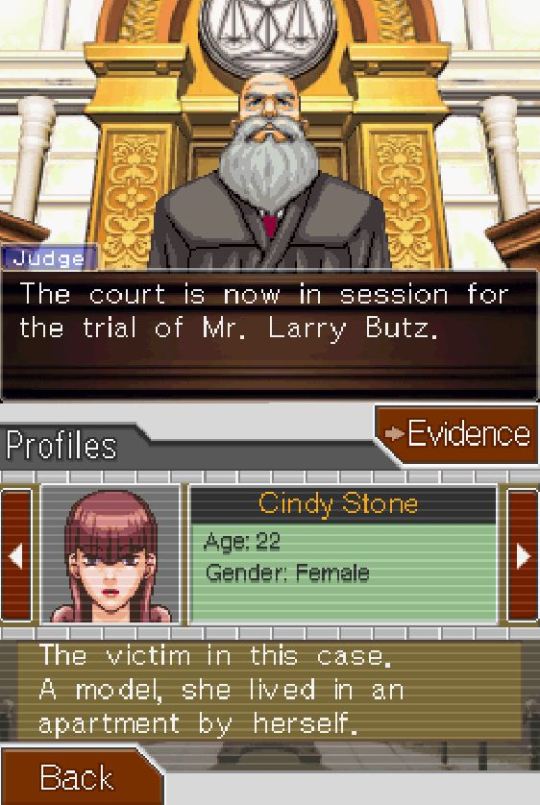
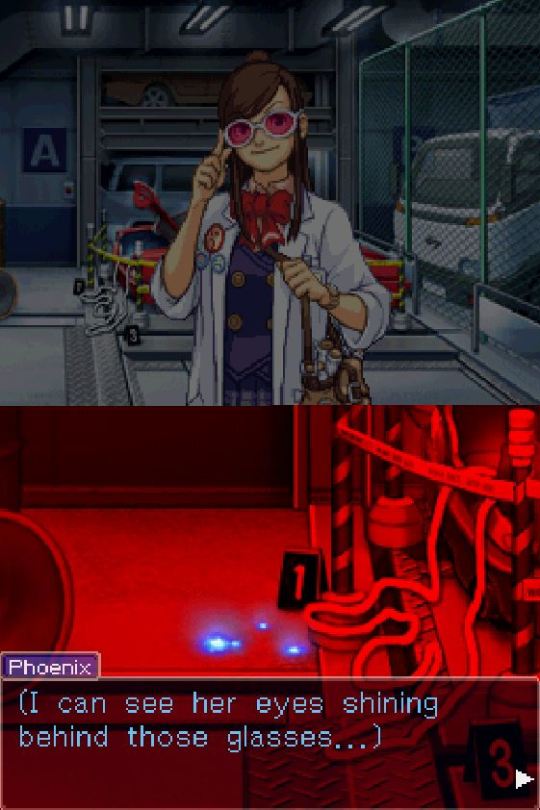

1,047.) Phoenix Wright: Ace Attorney
Release: October 12th, 2001 | GGF: Adventure, Visual Novel, Detective, Mystery, Puzzle | Developer(s): Capcom Co., Ltd. | Publisher(s): Capcom Co., Ltd. | Platform(s): Game Boy Advance (2001), Nintendo DS (2005), Windows (2005), iPhone (2010)
2 notes
·
View notes
Note
ok ok so about the scuffed run. it was of the uhh crossover game. i never touched the court segements and i still have 0 idea how courtroom pvp works. but i existed to like. get sent really fucked up glare ridden dusty screen photos of my friends ds to do all the puzzles for him. because im good at puzzle games. thats my jam. and alos because hes been stuck on the second puzzle of the game for uh. 5 years. it was. i couldnt let that continue. so that was my job. i get metaphorically handed the ds (i could not be physcially handed the ds due to distance reasons) to complete the layton puzzle sections of the game. and he would do the lawyer parts. in return i got sent updates on the story and screenshots of important/funny dialogue. after completing i decided 'you know what this was fun enough ill go check out those lay on ton games' and thusly we have completed what i think is the true way to go about the crossover game. by cooperation. also it now means that together we make the full triangle of nintendo ds mystery visual novels and i think thats wanderful. the crossover game was brilliant btw i enjoyed my time.
this is great
#5 YEARS ?!?!!? got damn just look up a walkthrough at that point#i admire the dedication and improvisation though#teamwork makes the dream work etc etc#cramswering
1 note
·
View note
Text
2022 Favorite Video Games

Another year, another instance of me not really putting in the time I used to for this favorite hobby of mine. Yup it’s true, 2023 was once again a year I really did not play a lot of games in. I found myself fairly busy and not having as much time as I would have liked to play games. Sadly it has been really difficult for me to manage time in my adult life as of late, and often I see what free time I do have going towards other hobbies with more immediate pay off. With all that said though I really wish I could be back to gaming like I used to be when I was younger. I like to think what I did play was at least of high quality but with my taste that might not quite be true. I suppose I should let you be the judge of what I wasted my 2022 on. What I did play I wanted to talk about , so although it’s not really much, I hope it still makes for an interesting read.
AI the Somnium Files: nirvanA Initiative

The first the AI the Somnium Files was a revolutionary title, no it didn’t do anything to change the landscape of visual novels, and no the narrative wasn’t ground breaking, it was revolutionary because of one thing: Kotaro Uchikoshi finally got a game with a good goddamn budget! Woo boy, you dunno how good that felt, the man is a legend and has created some of the best visual novels in the industry but the last couple generations seemed like no matter what he just couldn’t get major backing.
I’m really glad the first AI happened, and I generally had a lot of fun with this second entry in the series as well, but I couldn’t help but feel a lot of the magic was gone from the first game. That isn’t to say, AI Ni, as the game has been dubbed, is a worse game; just that the first AI was exciting and I didn’t know what to make of it but now I have certain expectations from a sequel and AI Ni more or less met them all just as I thought it would. The game play is a bit more polished, and some puzzles felt a little more fair this time than in the first but besides that, under the hood it’s just what you’d expect.
I definitely did enjoy a lot of the new characters introduced in AI Ni, it was a smart decision to really center about half the game on an all new cast--and I thought they were just as dynamic and interesting as the characters from the first game. It helped that their interactions with the original cast made for some material that we couldn’t have see in the first AI game too. The main premise and murder behind the game is also some grade-A fun Uchikoshi, the man is always able to write great sci-fi goobly gunk in such a fun way that I just will always love the his work. Basically, if you liked the first AI you’ll like this one. And that’s all I have to say about AI Ni for better or for worse.
Chaos;Head: Noah

The year was 2008 and I was nearly finished with High School. I was in the peak of my youth, and at the time couldn’t be a bigger weeb if I tried. I stumbled across this one interesting anime, based on a game I never heard of. It’s a visual novel and I had only just recently got into those games because of the many excellent ones released on the Nintendo DS. I can’t wait to try this out. That anime was Chaos;Head and oh boy did it begin a new chapter of my life.
I don’t know how to stress this enough, there was no market for this stuff back when it came out. Fan translations were incredibly slow too, and often involved having to run some Japanese's version of windows and even then only certain routes had English patches and the other parts of the game were still in Japanese and it was a mess. I can’t even fathom that I finally can own this! And that it is in English!
Chaos;Head is the original and progenitor of the science; adventure series otherwise known as that series that Steins;Gate was in. In a way it makes a lot of sense why Steins;Gate took off to such explosive levels of popularity and overshadowed this game, but that also is kind of what makes Chaos;Head special.
It’s so much grittier and more violent, it has a lot less mainstream appeal to it than Steins;Gate with an immediately lovable and quirky cast. Instead you have an incredibly flawed protagonist like Takumi who is an insanely flawed individual that manages to grow into somebody better. He has no self esteem, agoraphobia, and chooses to run away into fantasy from anything difficult. Plus he exhibits all the toxic traits of the fandom at that time but that makes sense since he completely devotes himself to said nerd culture in his attempts at avoiding reality. He’s a difficult character but honestly one of the best examples of a flawed protagonist and unreliable narrator in video games, hands-down.
Light Fairytale Episode 1

I ended up stumbling upon this game completely by accident. Being a love letter to the classic PSOne era JRPGs and essentially being made by one guy really endeared it to me. Episode 1 is pretty short, maybe only 2 hours or so but it’s a brisk well produced vertical slice of a realized game, and I had my fun with it. No, it’s not fantastic or anything, but it really helped to entertain me one weekend and I ended up playing it twice even, the second time with the perspective of the main heroine. There’s a lot of personality in the game and it’s obviously a passion project which really shows. Trust me, I buy Kemco RPGs I know the whole “cheap profit off nostalgia” grift better than anyone, so when true passion is there, you really have fun with the game.
Pokémon Violet
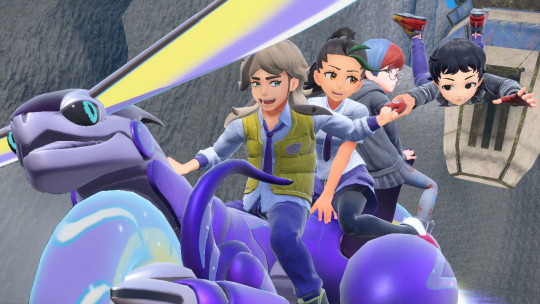
It’s really easy to dunk on Pokémon Scarlet and Violet. I know I did. These games are a mess!!! What a glitchy and bug ridden, unfinished, and lacking polish game. And this is one of the most profitable and beloved IPs the world has! What even is going on?! It’s easy to feel jaded and hate the game for it. Honestly the game does nothing to win you over when you start playing it. But if you give it time, damn, they really did deliver a good game after all. I know that’s a bit shit, right? “Oh the game is bad, but if you play it enough it becomes good!” I know, I know. If anyone told me that about any old random game I wouldn’t want to bother with it and think they’re an obsessed fan that doesn’t want to admit the shortcomings of their fave series. But in Pokémon's case, it’s true! Or shit, maybe I am an obsessed fan that doesn’t want to admit the shortcomings of one of my fave series. One or the other.
Honestly it’s a tragedy the development was so rushed and that it runs as poorly as it does with so many glitches. By the end of the game you can really see how creative and inspired GameFreak was. They begin to do stuff I always wanted to see them do in Pokémon games. The story begins to really take shape and becomes one of the best plots the series had since Sun & Moon. The game play loop becomes even more fun and rewarding, and worth all the bugs to get through for just one more minute. Just one more! I found myself utterly addicted by the closing hours of the game. It’s a shame all this great stuff is tied to such a poorly made game.
Sega Genesis Mini 2

The model of Genesis I grew up with was actually the Model 2, in fact I was so accustomed to the Model 2 I legit never saw the Model 1 Genesis in my entire life until the internet came along. It’s weird, I owned the Model 2. My best friend owned the Model 2. My cousins owned a Model 2. I just thought this was what a Sega Genesis was and that was how they all looked. I didn’t even know it was a Model 2. So naturally, another Sega Genesis Mini console after the incredibly well made first one, and it’s shaped like the Model 2? Sign me the funk up, brother!!!
It also helps that this time around the mini console is packed full of tons of Sega CD games, something the original was lacking in. If anything you might even want to call this the ‘Sega CD Mini’ instead. The game list is pretty solid, though I am bummed about the lack of Lunar games which the Japanese version got and which we didn't. That shit is whack. Also no Snatcher is just downright infuriating, c’mon you negotiated the rights to Castlevania Bloodlines, get off your asses and go back to Konami for Snatcher, it’s only the most prized and expensive Sega CD game ever made, like you know, an easy console seller. I usually never hack my mini consoles and just keep them stock, but yeah if a hack ever comes out I’m adding Snatcher, screw it.
Okay, enough complaining, I love this little guy, it’s a gorgeous mini console, and I know I’m going to end up playing it tons when I can. I love how well it emulates the game, the borders look snazzy on it and the selection has some truly great choices like Crusader of Centy a game I definitely need to play one day. I also appreciate the extra mile M2 went just to get this thing made and how they gave us some quality of life improvements like the ability to switch from the North American and Japanese soundtracks of Sonic CD in menu and a new easy mode for Phantasy Star II.
Shenmue

Like I mentioned in my anime thread, the recent Shenmue anime had me replaying this game again this year and man was it a blast! I really appreciated the insane amount of details the game had and in general the less-than-stellar elements that haven’t aged well only make the game more charming–especially the voice acting. But at its core is such an engaging and ambitious title that really just screams Dreamcast. This was an era full of experimentation and doing things like no one else had. It was an era where companies threw insane money at projects that they would definitely never make it back but who cares, it was now or never. Shenmue encapsulates all of that.
It’s at times a really dumb game with some really jank controls. But it’s also at times a game that feels alive. The sandbox world it represents is tiny, hell even its sequel makes Shenmue 1’s world feel like a joke, and today we have sandboxes the likes of which they couldn’t even dream about when this game was in development, but still somehow everything feels so alive. Interacting with the cast is so good. Learning new martial arts or just about their day, it doesn’t matter, seeing all these NPCs grow and change over time is still special, even today. There’s an insane amount of detail to everything and the amount of interaction the player can have is just stupid at times. You can open cupboards to pull out shelves to pick up an item to turn side item around to read the bottom inscription on said item. It’s a whole lot, games today don’t do that amount of detail, I really appreciate it so much today in 2022.
Who knows if Ryo’s journey will ever find its ending, the future looks just as bleak now as it did when Shenmue 2 originally flopped, but I think anyone who enjoys this era of games should definitely experience the start of this journey.
Xenoblade Chronicles 3

Xenoblade 3 feels like the crowning work of Monolithsoft. It is as if they perfected almost every aspect of their core identity as game developers in this one title. It’s a masterpiece and I don’t mean that lightly. The game provides easily the best combat in the entire Xenoblade series, hell maybe even all Xeno games, I am feeling just that bold. It manages to be just so incredibly fun to play and yet constantly finds ways to keep evolving, even towards the tail end of the game after 60 or 70 hours or so, the game still throws plenty of new elements and refreshes the system and how combat works. It never gets stale and on the flipside never feels overwhelming. Xenoblade 3 is the cumulation of years of work all coming together, even if that wasn’t intentionally so, as a third in a line of games, and as how well crafted as it is, it feels that way--it can’t help but to have that impact. If it weren’t for the staff working on the game being vocal that it isn’t an end to their Xeno games I could even swear this was some grand finale.
Oh and also did I mention you can combine and transform into giant robots?! Like hell yeah, what isn’t there to love about this game?!
The game has one of the most realistic and personal feeling cast in the series. I personally related a lot to the character Taion all throughout the game, but every character manages to be fleshed out and brings an interesting perspective to what we are seeing. At times the plot can get a bit heavy, I kind of swear Tetsuya Takahashi really wanted us all to check out his pretty sweet Gundam fan fic, but this is the kind of stuff I love with these games. The return of super long and well animated cutscenes like the Xenosaga games had really surprised me as well. I know some people aren't crazy for 30 minute long cutscenes, but I dig this stuff.
Overall Xenoblade 3 is very easy for me to call my favorite game of this year. I know I didn’t play many but at least with all the hours of this game behind my belt I feel I can say I chose quality over quantity in this situation. The entire game just feels like a magnum opus for Monolithsoft and Tetsuya Takahashi. I honestly don’t know how they’ll top this one any time soon.
#new years#video games#ai the somnium files#ai the somniun files nirvana initiative#chaos;head#chaos;head noah#light fairytale#pokemon scarlet and violet#pokemon#pokemon violet#sega genesis#sega genesis mini#sega genesis mini 2#shenmue#xenoblade#xenoblade chronicles#xenoblade 3
3 notes
·
View notes
Text
Pre-Production part 7
I was also focused on the mechanics of the game. I had already done some research on what game engine to use for the previous idea and had decided that I would use either unity, Game maker Studio 2, or Ren Py. At this point however, since I decided I should make a simpler and more visual novel and puzzle oriented game Game maker studio doesn't really seem like a great option anymore, since it is difficult to do UI with it.
I also looked at the different games that had inspired me so far and took notes on how I could emulate some of their gameplay and mechanics.

Finally, I brainstormed some ideas for the games UI and gameplay
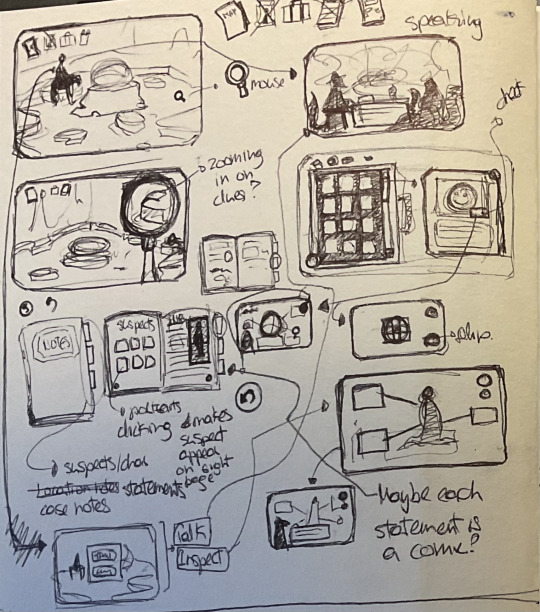
Bibliography:
Professor Layton and the Curious Village (no date) Nintendo of Europe GmbH. Available at: https://www.nintendo.co.uk/Games/Nintendo-DS/Professor-Layton-and-the-Curious-Village-272563.html (Accessed: May 1, 2023).
Ramée, J. (2022) Beacon Pines, gamespot. Available at: https://www.gamespot.com/articles/27-games-coming-in-2022-that-you-shouldnt-overlook/1100-6499427/ (Accessed: May 3, 2023).
Sancho, M. (2021) Tiny Room Stories Walkthrough & Guide, Mejoress.com - Web de videojuegos, trucos y guías. Available at: https://www.mejoress.com/en/tiny-room-stories-walkthrough-guide/ (Accessed: May 3, 2023).
Screenshots (2019) COSMOCOVER. Available at: https://www.cosmocover.com/newsroom/tangle-tower-unravel-the-strangest-murder-mystery-today-on-steam-nintendo-switch/ (Accessed: May 3, 2023).
Tangle Tower (2019) Steam. Available at: https://store.steampowered.com/app/359510/Tangle_Tower/ (Accessed: May 3, 2023).
0 notes
Text
anyone play this back in the day? never figured out how to get the true ending...

71 notes
·
View notes
Text
Professor vs Lawyer vs Bear: An Analysis of Narrative Puzzle Games
Note: For what I mean by aesthetics, you can check out my FAQ page here. For what “ludic” means, use Google.
Narrative puzzle games are and always have been a rare breed. Yet they perfectly encompass the ludic aesthetic of mystery, a very prevalent aesthetic in other mediums. They deliberately deliver on the holmesian feeling of cracking a case wide open unlike any other genre. However, as I pondered the rarity of such games, I noticed the subtler mechanical differences in the genre’s three largest representatives: Phoenix Wright: Ace Attorney, Professor Layton and Danganronpa.
In a large sense, they all seem identical in style at first. Yet taking a more in depth look at the mechanics, the three games deliver largely different experiences based on the themes they encompass. Strangely, the games seem to spell it out for us in some oft repeated mottos: “To turn this case around,” “This reminds me of a puzzle” and “Thrills, chills, kills!”
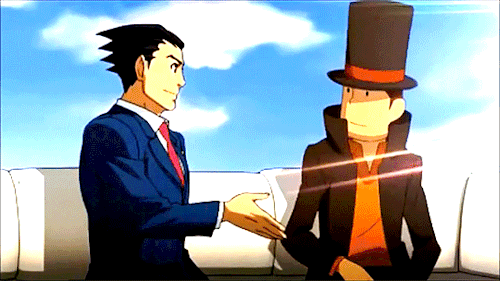
The Professor Layton games were originally made with the puzzles in mind; the story came later on. Therefore, the games have a traditionally dissected structure: the narrative component, and the gameplay component. The Professor Layton games are usually played for their IQ test-like puzzles, which are discovered randomly when talking to some characters or when advancing through the story. The narrative has, since the beginning, taken a backseat to the gameplay. As such, the story could be a simple saturday morning-style cartoon plot, following a holmesian figure through a fascinating mystery, while the player solved puzzles. The Layton games take the player along for the ride rather than let him be a part of the story. However, as they went on, the puzzles tied more into the story and the game could finally be called a Narrative Puzzle game.
Layton’s approach to puzzles is a lot more ham-handed than its brothers, not trying to tie them into the story or characters whenever it is not necessary. But because they are smaller in scope, they are accompanied by the need to utilise more direct deductive and inductive thinking rather than thinking by contradiction, which are more prevalent in the other two games. Unlike the other games, Layton never cares about how you arrived at a conclusion more than it cares about the conclusion itself.
Layton never aims to have that big cathartic holmesian moment, rather opting for smaller puzzles and having the larger mystery be solved by the titular character as a cutscene-type reward. That aesthetic is never aimed at throughout the series as a ludic component, but only as a narrative one, expressed through the language of film rather than game.
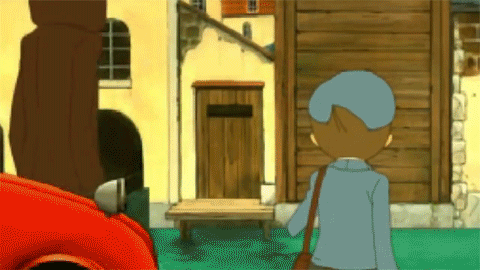
In the Ace Attorney series you play as a lawyer (mainly Phoenix Wright), where the main mechanic of the game is catching contradictions in witnesses’ testimonies. There is no time limit for these, only a health penalty for failing to catch the contradiction. This mechanic is complemented by investigation segments, which serve to make the player understand the case before the trial. Phoenix’s bluffing has become a running joke in the series because it is a common writing tool to guide the player’s abductive reasoning (which is not as commonly used as deduction or induction). Therefore, the Ace Attorney series encompasses the basest definition of the Narrative Puzzle game. It interweaves the plot and gameplay beautifully in order to deliver its big detective story climax, making the player feel like the Great Detective himself.
Its mechanics try to deliver on the themes of conviction and trust between lawyer and client, as well as the importance of dialectics. To do this, it is patient, with penalties to incentivise the player to be patient and thoughtful, while its visual and audio design deliver on the feeling of excitement necessary from a mystery story (Consequently, Pursuit~Cornered has become one of the most iconic video game tracks of all time). To sum up, what Ace Attorney wants to be first and foremost is fun to play.

On the other hand, Danganronpa is a game that wants you to be constantly uncomfortable. It is a game about high school students that are “Ultimates” in their fields being forced into a killing game seemingly coordonated by a robotic black and white teddy bear that claims all it wants is...Despair (And yes, it is just as all out bonkers as you imagine it to be). After each killing, the participants are forced to take part in a Class Trial in which they have to find the killer to survive.
The game takes a lot of its mechanics from Ace Attorney, but adds its own twisted style to the proceedings: the testimonies are now all the students hurling theories, deductions and swears at each other on a time limit and the contradiction is not punctuated by an objection, but by a bullet blowing apart the words. However, HP (or rather, credibility) reaching 0 is usually accompanied by a simple “Try again?” prompt, because strangely, the game wants you to succeed. Usually at the end of the trial, you have to play a rhythm mini-game in which you argue with a participant who is desperately denying every accusation thrown their way. The feeling of unease is only made deeper by the bonds you are able to make with the other students during the free time events, who are always liable to be murdered or become murderers during the killing game. In the end, Danganronpa is a game that wants you to feel fundamentally uneasy and distrustful of everything around you, that hits you when you’re the most relaxed. It is a game whose themes of Hope and Despair come through beautifully within the mechanics themselves.

To be perfectly candid, after so much thought and consideration, I am starting to question whether all of these games belong under one umbrella. All of these subtle differences in mechanical design change the feel of the games tremendously and manage to deliver on very diverse aesthetics of gameplay, from simple fun to complete despair all on the backdrop of mystery, puzzle solving and complex plots. This is a genre brimming with storytelling potential and I am awaiting more and more quality from it in the future.
#ace attorney#phoenix wright#danganronpa#professor layton#monokuma#game design#gaming#visual novels#nintendo+ds#playstation vita#essay#narrative puzzle games#mechanics#analysis
20 notes
·
View notes
Text
Spuffy enjoyers have been looking in all the wrong places. The real treasure was to be found in Buffy the vampire slayer games for the Nintendo DS! What more can you ask for than a 10 hour long rpg/visual novel/puzzle/first person shooter!?!?!?? thing about Buffy saving her damsel in distress with such scenes as this.
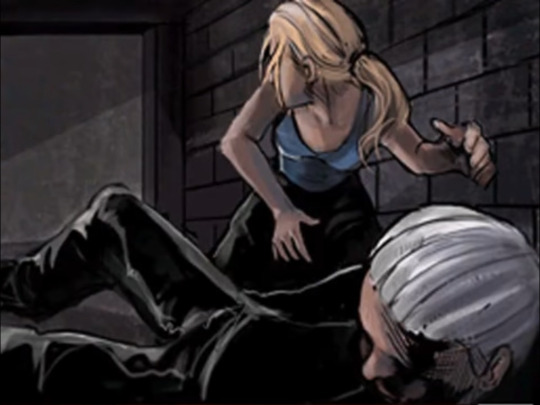
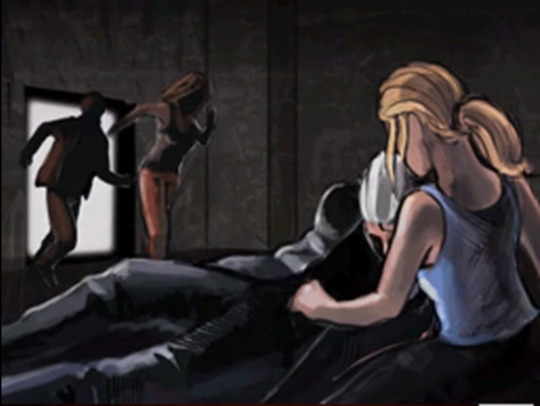
9 notes
·
View notes
Text
Hotel Dusk: Room 215 (Nintendo DS)
in our quest to check out more visual novels this year, we decided to play through hotel dusk, a rather niche ds game that makes heavy use of the ds’s gimmicks, such as closing the system to solve puzzles, using the touch screen for the entire game, and having you hold the ds like a book.
despite the short length, hotel dusk turned out to be one of my favorite games I’ve played this year! kyle hyde starts off as a sort of assholish protagonist, but as you learn more about him you sort of figure out why he acts the way he does. there’s a very interesting cast of characters, all with their own problems and reasons for being at the hotel, and while most of them weren’t really designed to be likable, I still enjoyed learning more about them. the artstyle for this game is also fantastic, the black and white character portraits in contrast with the dull colors of the hotel works extremely well. the portraits also have multiple animations too just while conversing that really make the characters feel more alive and adds extra emotion to a lot of scenes in the game.
the music in this game is also extremely well done, and wouldn’t feel out of place in an ace attorney game. the very relaxing, chill vibes of the hotel easily turn into a tense atmosphere when kyle finds enough clues to start grilling someone for information, and it all just works excellently. my favorite songs are “on the rocks” and “the last sleep.” I was also surprised by this game’s use of words like damn and bastard, and the frequent mention of alcohol for being a ds game, it’s interesting to see for a nintendo game that even was referenced in super smash bros.
overall I’d very much recommend this game to anyone who likes visual novels or adventure-y point and click games, it’s also only about 12 hours long with a guide. I would recommend being careful with dialogue choices though, as many options can net you a game over either through acting like an ass or saying the wrong thing when interrogating someone.

11 notes
·
View notes
Text
GOTY 2021: #5 - The Great Ace Attorney Chronicles
While I’ve always been aware of Capcom’s famous ace attorney, Phoenix Wright, and had a general knowledge of the gameplay found in the now 10-year-old franchise, they were something I appreciated more so at a distance during the Nintendo DS era. Like most people, I have genres that I prefer, some that I have little exposure with, and others that I’ve skipped entirely for one reason or another.
It’s funny to think about in hindsight, though.
I’ve always enjoyed both reading and puzzles—the target audience for Ace Attorney. For whatever reason, however, those interests didn’t always translate to video games. Give me something like Paper Mario, and I was all in. The visual novel genre was another beast entirely, and for a lack of a better explanation, they just didn’t mesh with someone like me who preferred being able to take action.
But back in Spring of this year, after Capcom announced the localized collection of The Great Ace Attorney Chronicles—packaging both games formally exclusive to Japan—I decided to take a chance at something new and preordered it.
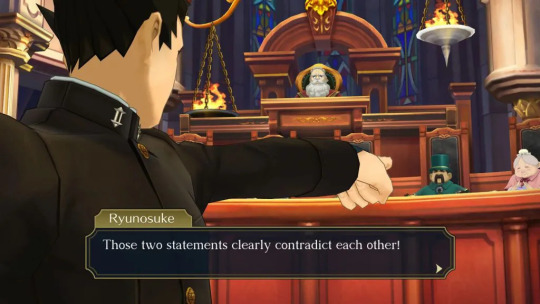
Set during Meiji-era Japan, several decades before the modern-day courtroom setting of Phoenix Wright, Chronicles stars his ancestor, Naruhodo Ryunosuke, an academy student that is thrust into the world of law when he’s unexpectedly forced to defend his own innocence from accusations of murder.
The Great Ace Attorney Chronicles spans two games with five episodes each. Every episode revolves around a unique case while also adding to the overarching story of both Ryunosuke and his assistant, Susato Mikotoba.
The core gameplay requires a lot of reading—if you’re someone who enjoys a good narrative, you’ll absolutely find it here. If you prefer to skip through dialog quickly to get back into the action, however, this series may not be for you. In between the longer conversations you’ll explore crime scenes, and most importantly, look for the truth as the drama within the courtroom develops. It’s a fairly linear experience—to the point where a “reader” mode can be enabled to allow the game to solve the puzzles for you while simply enjoying the story. Personally, I enjoyed the puzzles as they generally revolve around an attention to detail, whether it’s a piece of evidence or a callback to a prior conversation.
At the time of writing this, I’ve only played through the first game, Adventures, but I’m looking forward to returning to it next year for the second act. If the first game is any indication, then I expect more good times with this one in the future.
I can’t close this one out yet before mentioning what was easily my favorite aspect in The Great Ace Attorney, and that is the characters of Herlock Sholmes and Iris Wilson. In the original Japanese release, Sir Arthur Conan Doyle’s famous detective featured as a part of the main cast with a Capcom-flavored twist that gave both a Steampunk-like aesthetic. For legal reasons, Holmes and Watson are renamed in the international releases, but fear not, as there is no lack for references within their depictions from nods to Doyle’s short stories to the well-known residence of 221B Baker Street. The inclusion of Holmes since inspired me to start a trek through all of Doyle’s Sherlock fiction this year, which I read alongside playing the game.
That’s what I think makes video games great; we tend to pick up new hobbies or interests that, in a way, blur the lines between the world of the game and our own. The Great Ace Attorney Chronicles is worth the admission on its own merit, but it climbed this high on my list for simply being inspiring.
It’s one thing when the game leaves an impression on you, but when those impressions jump out the world and seep into yours, it becomes that much more lasting.
7 notes
·
View notes
Photo

Ace Attorney Investigations: Miles Edgeworth was out today in 2009. A spin-off that focuses far more on deduction and clue gathering.
#ace attorney#Gyakuten Kenji#phoenix wright#adventure#visual novel#crime#mystery#puzzle#nintendo ds#handheld#portable#spinoff
29 notes
·
View notes
Text
A Window to the Soul: Game Mechanics and Characters in Ai: the Somnium Files
Spoiler-free!

Ai: The Somnium Files is an adventure game/visual novel for PC, PS4, and the Nintendo Switch by Spike Chunsoft in September 2019.
Written and directed by Kotaro Uchikoshi, known for his Zero Escape Trilogy (999: Nine Persons, Nine Hours, Nine Doors (DS), Zero Escape: Virtue’s Last Reward (DS), and Zero Time Dilemma (DS, PS Vita, PC), also available as the Zero Escape Trilogy on Steam and PS4), this game once again displays Uchikoshi’s signature combination of suspense, humor, and ludonarrative harmony that fans of his previous games are familiar with, alongside a cast of complex, compelling characters you’ll absolutely fall in love with.
For all my fellow Zero Escape fans, you probably remember the issues the series faced with financing, which ultimately lead to Uchikoshi helping to establish Spike Chunsoft and the eventual release of Zero Time Dilemma. In AitSF, more than ever, the fruits of that partnership are apparent. It feels we finally get to see a complete picture of Uchikoshi’s vision; Featuring fully animated 3d models, fully voiced dialogue, and some incredibly goofy and self-indulgent dance sequences, this murder mystery (and yes, it is a murder mystery) is absolutely worth it’s full price and your time.
The game has multiple endings (About 5, without checking), all leading up to and feeding into the true ending. One notable feature is that the timeline allows you to jump into previous played sections at any point of the chapter, and even provides summaries of the events that happened in each “node,” so unlike in the original 999, you don’t need to replay through every scene of dialogue to get to each ending.
Rather than spend time analyzing the story itself- something that can’t be done to a satisfying level without spoiling the whole thing- I’ll just say that the way Uchikoshi literally has us get inside the heads of characters by “syncing” with them is a great story device, and is realized extremely well in the gameplay.
For me, the Sync was used in all the right places to push me into genuinely caring about some characters, that, without the sync, I would be sympathetic to, but not feel a real sense of attachment towards.
What follows is a breakdown and analysis of how well the gameplay is designed, and some non-spoilery discussion of characterization and character design:
Mechanics:
The core gameplay loop can be broken into two parts: dialogue and investigation, and “syncing.”
The investigation portion of the game is similar to most adventure visual novels- investigating crime scenes, talking to NPCs to advance the story, examining your surroundings, and in my case, clicking on scenery over and over again to get funny flavor dialogue.
The flavor dialogue does not disappoint- and for me, the best minor feature included in the game ties to this. When you click on an object, you get an initial string of dialogue- but the indicator with the name of the object will only get grayed out once you’ve seen all the text related to that object. For some people, this might ruin the “fun” of clicking over and over again- like in 999, where some bits of dialogue would only display on the 9th time examining an object- but for me, it was a godsend, because I didn’t spend any time wondering if I missed anything funny.
The Sync gameplay loop is also mechanically brilliant. Part of the in-universe rules, which are emphasized over and over, is that the main character, Date, can only spend 6 minutes within the subject’s “Somnium”- the internal dreamscape of their mind- and that staying any longer could result in disastrous consequences. As such, each Somnium loop attempt can (hypothetically) be experienced in chunks of about 8-10 minutes. This set time frame makes it a breeze to play the game in small sections at a time and let your mind breathe a bit.
The time limitation is challenging, but never infuriating; even when I messed up horribly and knew I had to restart a sync from the beginning, I would just use the time I had remaining to try out the goofier actions available to try out as puzzle solutions.
Somnium Files’ adaptability to being played in long sittings or in short bursts, while still maintaining an engaging, tense narrative is an incredible strength that not all games can boast of. Not a single part of the game felt like a slog or a chore to me, unlike a few puzzles in Zero Time Dilemma, where I ran into the perennial adventure game issue of “okay, so I have this item, but where do I use it?”, “how the hell do I even solve this puzzle without a guide” (I didn’t), and “what do I need to do to unlock the next sequence?”
Characters
So let’s talk about these good characters. Some of you probably recognized the art style for the game’s key visual as the work of Yusuke Kozaki, best known by many as the head artist and character designer for Fire Emblem: Awakening and Fire Emblem: Fates. Even in his work for the Fire Emblem franchise, you can tell he doesn’t care much for drawing armor- which puts him in the same club as literally every artist I know who draws Fire Emblem fan art. His designs really shine in a contemporary setting, with modern clothing, and really give the cast a unified, unique aesthetic. Moreover, the designs are beautifully translated into 3D as well.
For a game that was most likely well underway in development several years prior to the boom of the subgenre, the design for A-set, (AKA Iris), an in-game internet idol and streamer, is incredibly in line with those of many successful “Virtual Youtubers”- for that alone it deserves some accolades. Fittingly, as part of online promotion for the game, Chunsoft posted a series of video blogs starring A-set, as if she were posting to her own channel. (I missed all of these, and that’s a real shame, because I think they would have gotten me excited for the game if I had been paying attention.)
Despite Iris’ obvious and engineered marketability, I think my favorite design of the game is Aiba, the AI partner of the main character, whose human form only appears in Somnium and in the realm world as an AR projection imposed in Date’s cybernetic eye. The way her arms fade into glowing, electronic “nerves” at her arms is a subtle reminder of her artificiality, but her design also doesn’t make her more playful and goofy behaviors jarring in the least.
As far as personalities go, I would say that Date, our protagonist, manages to hit the perfect median- maybe even fusion- between the past male protagonists in the Zero Escape trilogy. Junpei, Sigma, and Carlos were all likable in their own ways, as the narrative character, but all had a level of blandness to them. To me, they served more as vehicles for us to participate in the Nonary Games.
In contrast, Date feels very much like his own, established person, and that’s not only a huge strength, but central to the overall narrative. (For all non-ZE fans reading this review- I apologize for the heavy use of ZE comparisons here.) Like Sigma, Date is a bit of a perv, but unlike Sigma in Virtue’s Last Reward, I didn’t feel squicked out by his behavior; Like Carlos, he cares immensely for the people important to him, and puts their wellbeing first; Like Junpei, he’s, also, a loveable moron.
There are other characters- Mizuki in particular- whom I can’t speak too much about without spoiling some of the enjoyment of their character arcs, but all of them have incredibly good and complicated interpersonal relationships both with and outside of Date.
Lastly, there’s Aiba.
A good companion character is worth their weight in gold. After all, most of the time, they’re who you spend most of your time with, and for that reason, the more “annoying” ones always catch more flac for being so. For me, Aiba easily slides into my top 10 favorite companion characters of all time, along such members as Maya Fey in the original Ace Attorney trilogy and Midna from Legend of Zelda: Twilight Princess. Most of the goofiest sequences in the game are instigated by her, and every time she’s on screen there’s bound to be something fun to do, not to mention the fact she’s our avatar used within Somnium. Combine that and her telepathic banter with Date, and you got a recipe for a dynamic duo.
In closing, every aspect of AitSF is absolutely delightful; It has tightly woven narrative gameplay, wonderful and complex characters, a storyline that, despite my best efforts, I couldn’t unravel the details of before they were revealed- and I didn’t even get into how great the voice acting is. If you’re looking for an enjoyable, self-contained game that you can beat in under 35 hours, Ai: The Somnium Files can’t be beat.
#ai the somnium files#aitsf#somnium files#game essay#game review#game design#narrative design#visual novel review#visual novels#bluerose writing#bluerose-essay#bluerose game writing#bluerose nonfiction
35 notes
·
View notes
Text


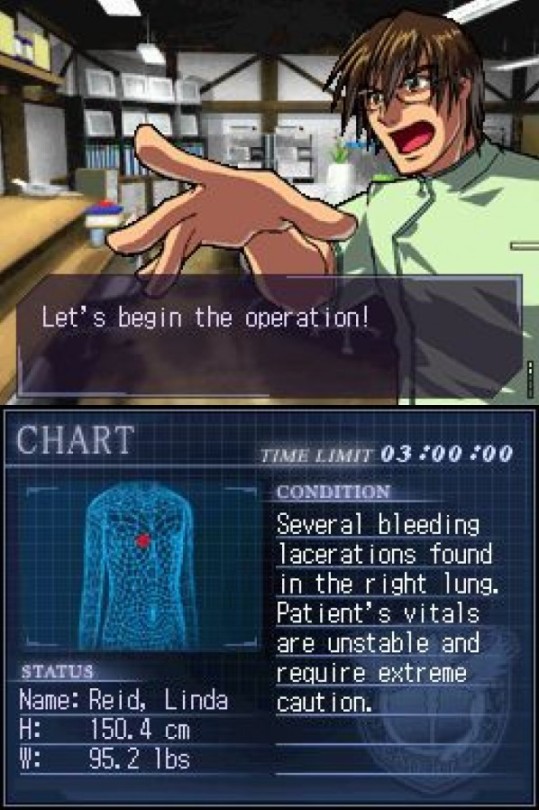
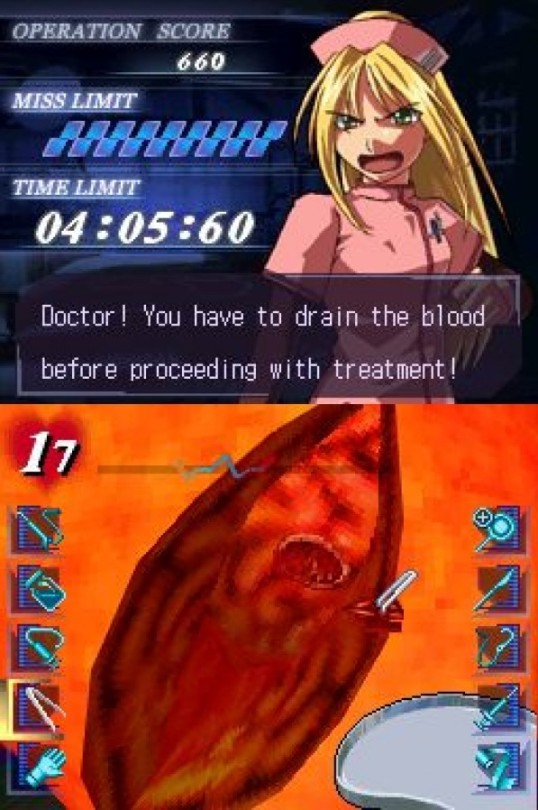
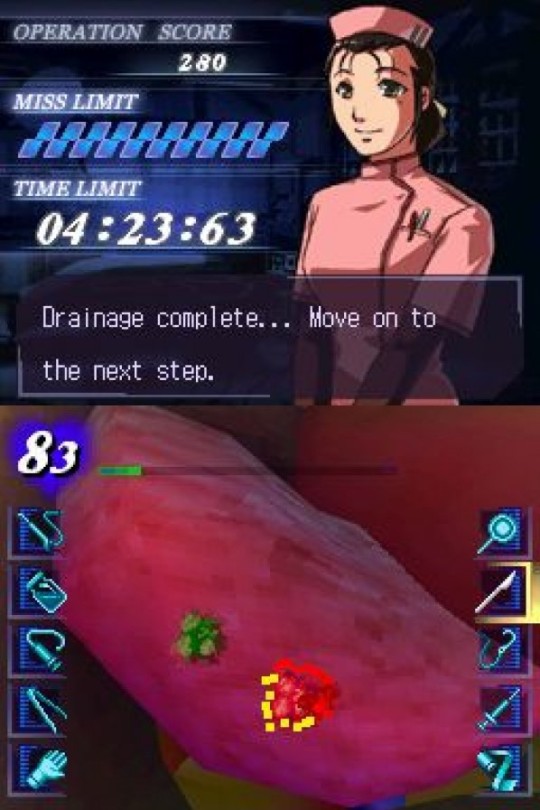
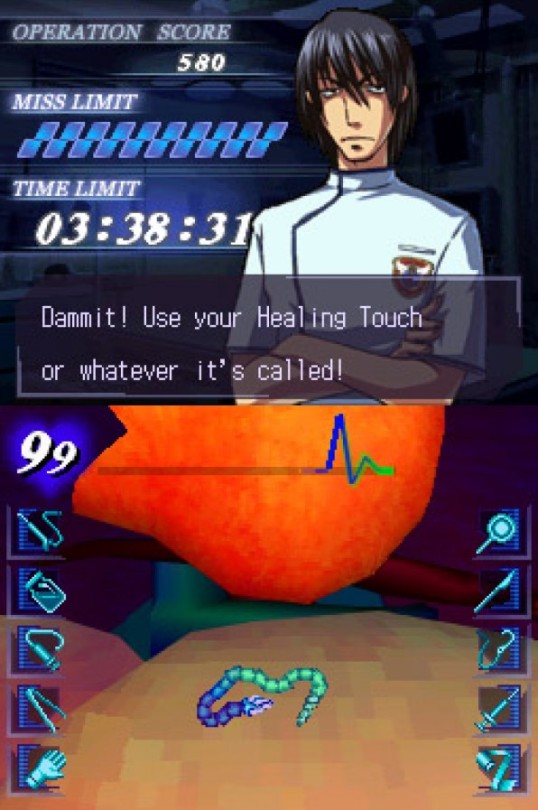
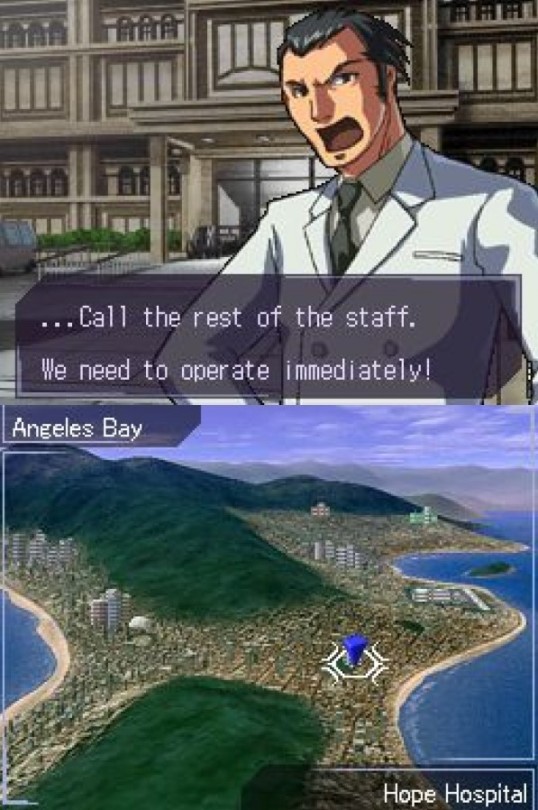
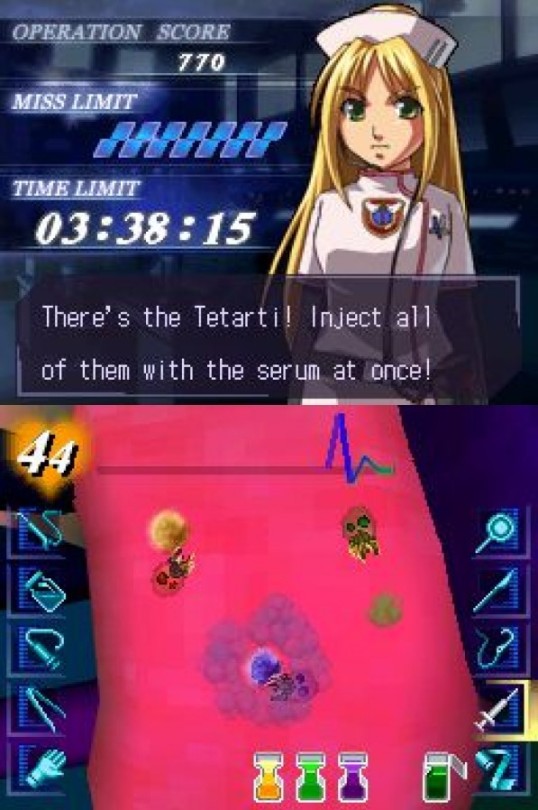
1,360.) Trauma Center: Under the Knife
Release: June 16th, 2005 | GGF: Arcade, Action-Adventure, Simulation, Puzzle, Visual Novel | Developer(s): Atlus Co., Ltd. | Publisher(s): Atlus Co., Ltd., Nintendo Co., Ltd. | Platform(s): Nintendo DS (2005)
0 notes